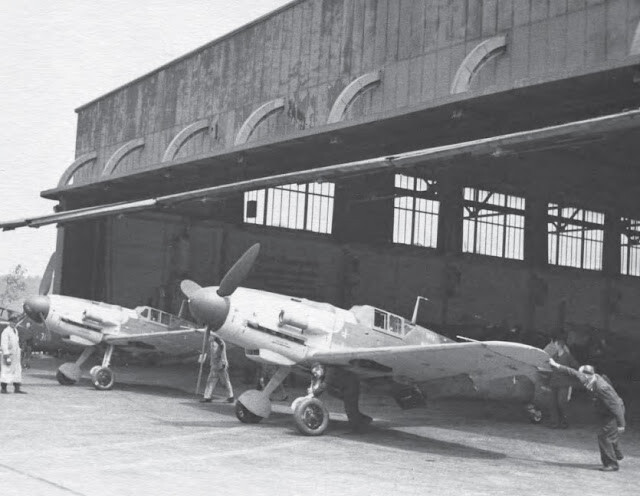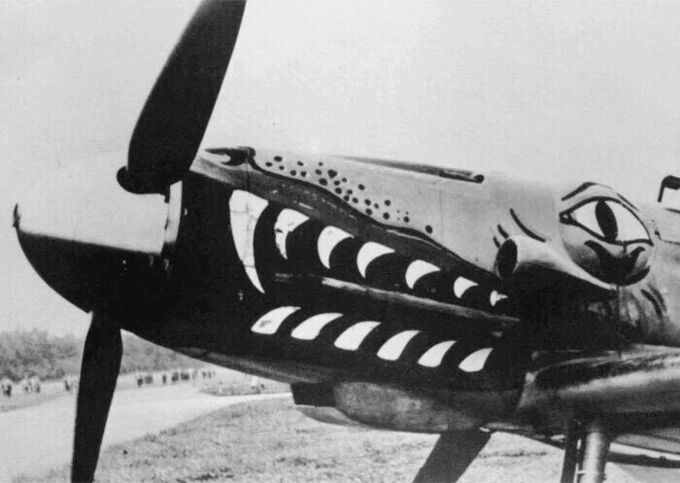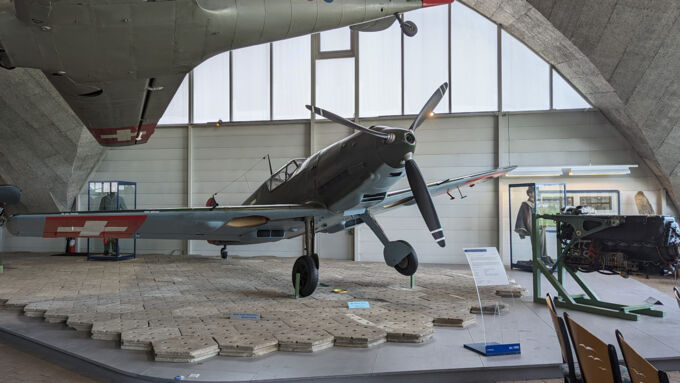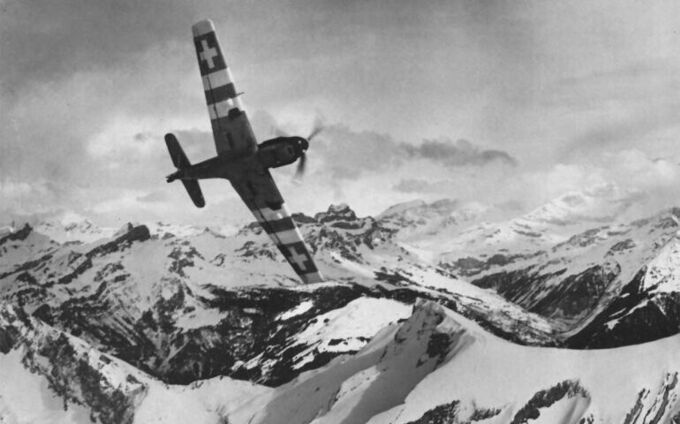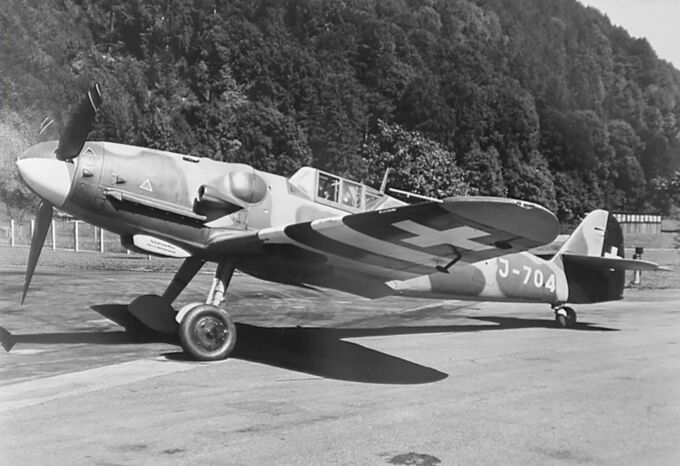Neutral Switzerland’s airspace was violated at least 6,501 times during the war, and her main cities were bombed numerous times by the Allies during their bombing campaign on Germany from 1942. This collateral, accidental and sometimes purposeful violation of Swiss neutrality meant that Switzerland needed fast, modern and effective fighters to defend her airspace, and the German ME 109 series proved to be just that.
Swiss Acquisitions
During the 1930s, the Swiss Flugwaffe consisted predominantly of biplanes such as the Dewoitine D.27 and the Fokker C.V-E. So, in order to update its already outdated air force, Switzerland had originally tried to purchase Spitfires from Britain with a license to build them, but this deal never materialised. Searching instead for an alternative, Switzerland turned to its rapidly expanding neighbour Germany and, in 1938, 90 ME 109 Ds and E-3s were purchased and delivered for 36.6 million francs, so that by 1939, the ME 109 made up about 93% of the Swiss Flugwaffe’s fighter arm. The company code of 'BF' was not adopted by the Swiss, hence why they are referred to here as ME 109s instead of BF 109s. Deliveries stopped soon before the German invasion of France, although others were obtained throughout the war. Some, mainly 'Friedrich' and 'Gustav' variants, were obtained through the internment of German pilots, and others were built from spare parts.
1940
During the German invasion of France (May–June 1940), Swiss ME 109s shot down 11 hostile aircraft which had strayed into Swiss skies.
For example, on the 1st of June, 36 HE 111s of KG 53 were intercepted by 12 ME 109 Es, and a furious firefight followed which resulted in six Heinkels downed for the loss of one Swiss ME 109, flown by Rudolf Rickenbacher, who was killed in the explosion. One notable encounter took place on the 8th June, when one BF 110 flown by Feldwebel Beiter of 4./ZG 1 was shot down by Swiss Messerschmitts near Triengen, after he had attacked an antiquated Swiss reconnaissance biplane. Hearing this, the head of the Luftwaffe, Hermann Göring, ordered 32 BF 110s escorting Heinkel HE 111s to fly over Swiss airspace in retaliation. Once there, they were immediatly intercepted by 14 Swiss ME 109s, leading to the loss of four 110s, without any Swiss losses. Such a defeat infuriated Göring, and he threatened sanctions and retaliation if this continued, which lead to a temporary ban on Swiss combat patrols, although AA batteries remained operational.
1940–1943
Under pressure from fascist Germany and Italy, which surrounded it, Switzerland banned its aircraft from flying within 50km of its border, to avoid skirmishes between BF 109s of different nationalities.
1943–1945
With an Allied bombing campaign against German locations near its borders becoming more and more likely in October 1943, Switzerland changed its policy, allowing its pilots to once again fly patrols along its borders. This time, Swiss pilots preferred to escort enemy aircraft to Swiss airfields, and then capture the pilots and their aircraft, although some notable encounters involving 109s still took place.
New additions
On the night of 28–29 April 1944, a German BF 110 G-4 carrying the top-secret and highly sensitive SN-2 'Lichtenstein' radar and the also secret “Schräge Musik” gun installation, flown by Staffelkäpitan Wilhelm Johnen of 8./Nachtjagdgeschwader 6, was following a British Halifax into Swiss airspace when he was hit by return fire from the bomber and had to land due to engine failure at Zürich-Dubendorf airfield in Switzerland, and was captured. Hearing that their top-secret radar was in the hands of a foreign state alarmed the Nazi regime, even if the Swiss government was neutral. However, a deal was arranged that the Swiss would destroy the BF 110 before they could examine it, in exchange for 12 state-of-the-art, German-made BF 109 G-6s, which would help to further modernize Switzerland’s air force, and compete with the newer American designs (the Swiss still examined the BF 110s radar without the Germans knowing Source).
Tension with America
On the 4th April 1944, B-17G “Little Chubb” of the 384th Bomb Group was limping back to its base after a particularly bad raid on Oberpfaffenhofen in Bavaria, where it had been chewed up by German fighters and Flak near Stuttgart. This excerpt from a combat report made by Engineer SGT. Raymond A. Newall of “Little Chubb” sums up the dire situation: “Our (B-17's) nose was badly hit by a shell fragment and bombardier Lt. Jesse L. Greenbaum was seriously wounded in the face.” (Source). Trying to get home, “Little Chubb” entered Swiss airspace and was met by ME 109s who escorted them towards Dübendorf airfield. Turning back for fuel, the Swiss ME 109s left the B-17 alone in Swiss airspace. Not knowing where to land and wondering what to do, the pilot of “Little Chubb” started to circle Lake Zürich. To their dismay, suddenly three ME 109 E-3s of Fl.Kp. 21 were sighted heading straight for them, as the Swiss mistook the circling for an escape attempt, and allowed their pilots, who were based at Dübendorf, to shoot to kill. As Newall later says, upon attack: “The plane immediately burst into flames”. The 'Messers' also killed one of the waist gunners and the bombardier. “Little Chubb” later had to make a forced landing on Lake Greifensee and the surviving crew members were interned.
Later that year, on the 5th September, a group of American P-51 Mustangs of the 339th Fighter Group were escorting the crippled B-17, 'Blues in the Night', back home to England, when they crossed over into Switzerland. Almost immediately, they sighted ME 109s of Fl.Kp.7 on patrol, and attacked. Not realising that they were over Switzerland and that these were 'neutral' 109s, the P-51s opened fire, and a dogfight broke out. Eventually, the P-51s shot down two 109s, one flown by Oblt. Robert Heinige, who survived the crash, and the other was flown by Oblt. Treu Paul who was killed. Such an incident prompted the Swiss to, from then on, paint their ME 109s with white 'neutrality stripes' to avoid confusion with the Luftwaffe’s Messerschmitts, although this didn’t always necessairily work, as the Germans sometimes mistook the stripes as D-Day invasion markings.
Swiss ME 109s: General Information
Swiss ME 109 E-3s; Main differences from German ones
| Differences | Swiss | German |
| Radio equipment | No (not when delivered, though some had it added later on) | Yes |
| Armament | 2x MG 29 7.45 mm machine guns above the engine, 2x 20 mm FF-K Oe 37 (one on each wing). | 2x compressed air-powered MG FF 20 mm cannons, 2x 7.92 mm MG 17 machine guns. |
| Official company denomination | ME (Messerschmitt AG) | BF (Bayerische Flugzeugwerke) |
Swiss units equipped with the ME 109
(Fl.Kp.=Fliegerkompanie or 'Flight company'. Swiss equivalent to a British Squadron)
| Unit | Fl.Kp.6 | Fl.Kp.7 | Fl.Kp.8 | Fl.Kp.9 | Fl.Kp.15 | Fl.Kp. 21 |
| Usage of ME 109s | 1939 -1946 | 1943 — 1947 | 1943 — 1949 | 1943 — 1947 | 1939 — 1947 | 1939 — 1945 |
| Base during WW2 | Zweisi-mmen, Bern | Meiringen, Bern | Meiringen, Bern | Sion airport, Valais | Payern airbase, Vaud | Buochs, Nidwalden and Dübendorf Zürich |
| Notes | First Swiss unit to shoot down an enemy aircraft during WW2, 10th May 1940 | It was a patrol of Fl.Kp.7 which was attacked by the Mustangs on 5/9/'44, resulting in one of the first Swiss casualties to American gunfire. | Mainly used the outdated 'D' variant until 1941. | This unit’s ME 109s were painted with garish eyes and shark’s teeth on the cowling. |
ME 109 variants used by Switzerland
| Variant | E-3 | D-1 | F-4 | G-6 | G-14 |
| Number used | 88 (8 built in Switzerland) | 10 | 2 (captured from interned pilots) | 13 (1 captured) | 1 (captured) |
| Used until | 1949 | 1949 | 1947 | 1947 | 1947 |
| ID number | J-311 — J-399 | J-301 — J-310 | J-715, J-716 | J-701 — J-713 | J-714 |
Surviving aircraft
There is only one surviving ME 109 which served with the Swiss air force, and that is the restored ME 109 E-3 'J-355' at the Swiss Air Force Museum, at Dübendorf, Zürich.
Colour schemes
There are many colour schemes for Swiss ME 109s. Here are a few.
- https://www.b17museum.ch/index_e.php
- https://en.wikipedia.org/wiki/Fliegerstaffel_6
- https://en.wikipedia.org/wiki/Fliegerstaffel_7
- https://en.wikipedia.org/wiki/Fliegerstaffel_8
- https://en.wikipedia.org/wiki/Fliegerstaffel_9
- https://en.wikipedia.org/wiki/Fliegerstaffel_15
- https://en.wikipedia.org/wiki/Fliegerstaffel_21
- https://www.luftwaffeinprofile.se/Bf%20109%20E3%20J-311.html

